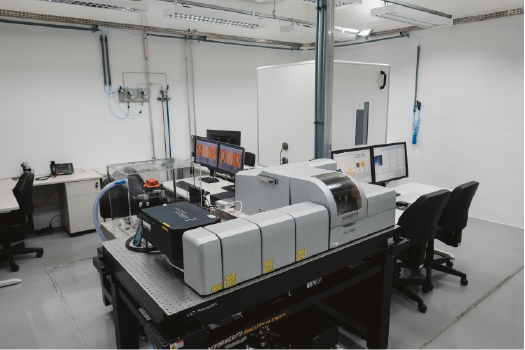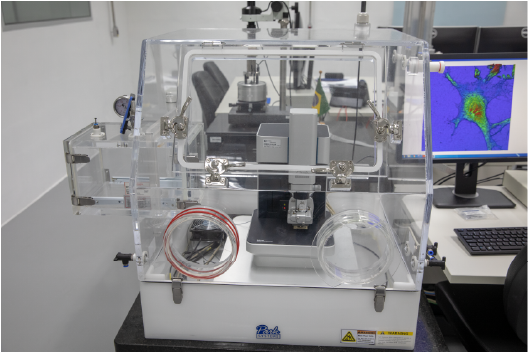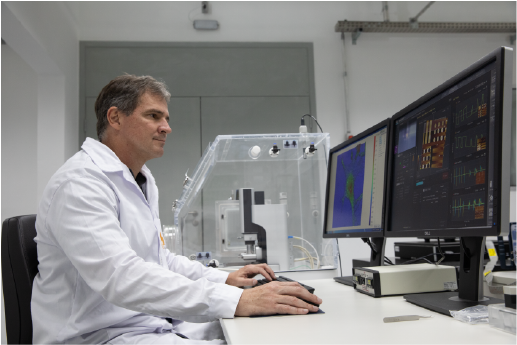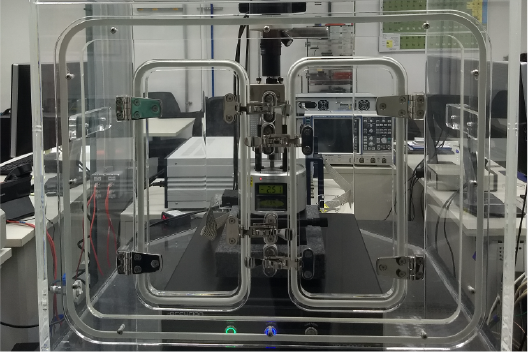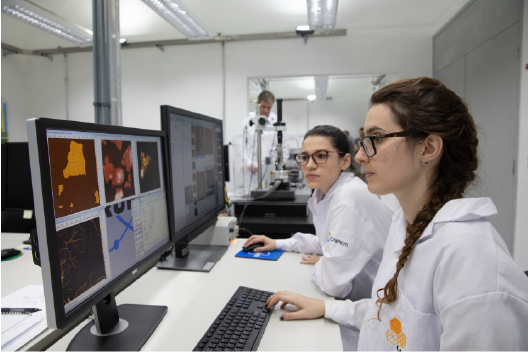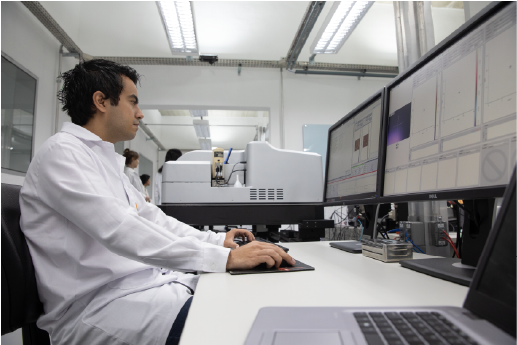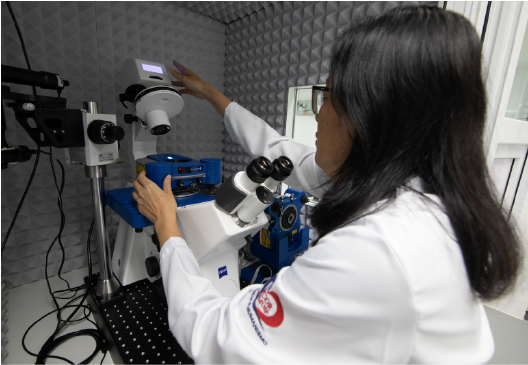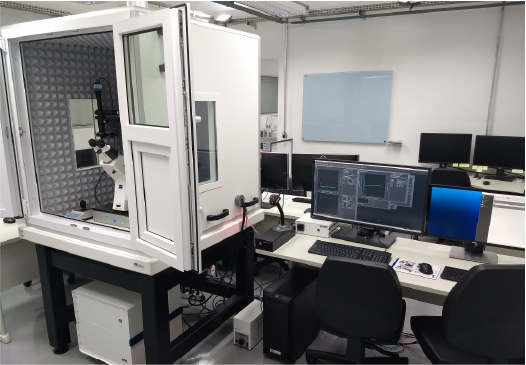Atomic force microscopy (AFM) has become a very present tool in surface characterization, due to its operational flexibility, variety of analyzed properties and resolution at the nanometer scale.
Open facilities have the mission of providing users with a research infrastructure with the best possible performance. They currently operate with four microscopes, with a wide variety of techniques related to the fields of physics, chemistry, materials science and biology. A team of specialists and technicians is available to assist in the execution of research projects, exploring the limits of available instruments.
Infrastructure
Park Systems - NX10
Description
The AFM NX10 is a flexible instrument for analyzing samples with different formats and dimensions. It is equipped with several optional modules, which make it possible to carry out a wide variety of related techniques. It stands out for its joint operation with its optical microscope, used for a previous optical location of the area of interest. It is suitable for scanning areas from 2µm x 2µm up to 100µm x 100µm, with temperature and humidity control.
Specifications
100µm x 100µm XY Drive
• 10µm Z Drive
• 24bit controller
• Stage for XY displacement of the sample
motorized (20mm x 20mm)
• Environmental chamber for humidity control
relative from 0.5% to 80%
• Room temperature control up to 60°C
• Optical microscope with 10x magnification objective
• Open liquid cell
Techniques
• Contact or Intermittent Contact (AFM)
• Lateral force (LF-AFM)
• Phase contrast
• Force Modulation
• Force spectroscopy
• Magnetic Force (MFM)
• Electric Force (EFM)
• Surface potential (KPFM)
• Capacitance (SCM)
• Capacitive coupling (dC/dz)
• Conductivity (c-AFM)
• Piezoresponse (PFM)
• Nanoindentation
• Nanolithography
Description
Specifications
Techniques
Park Systems - NX10
Description
The AFM NX10 is a flexible instrument for analyzing samples with different formats and dimensions. It is equipped with several optional modules, which make it possible to carry out a wide variety of related techniques. It stands out for its joint operation with its optical microscope, used for a previous optical location of the area of interest. It is suitable for scanning areas from 2µm x 2µm up to 100µm x 100µm, with temperature and humidity control.
Specifications
100µm x 100µm XY Drive
• 10µm Z Drive
• 24bit controller
• Stage for XY displacement of the sample
motorized (20mm x 20mm)
• Environmental chamber for humidity control
relative from 0.5% to 80%
• Room temperature control up to 60°C
• Optical microscope with 10x magnification objective
• Open liquid cell
Techniques
• Contact or Intermittent Contact (AFM)
• Lateral force (LF-AFM)
• Phase contrast
• Force Modulation
• Force spectroscopy
• Magnetic Force (MFM)
• Electric Force (EFM)
• Surface potential (KPFM)
• Capacitance (SCM)
• Capacitive coupling (dC/dz)
• Conductivity (c-AFM)
• Piezoresponse (PFM)
• Nanoindentation
• Nanolithography
Description
Specifications
Techniques
Bruker - MultiMode8
Description
The MultiMode8 AFM is an instrument suitable for high-resolution analysis, allowing scans in areas from 500nm x 500nm up to 10µm x 10µm. Used for analyzing nanostructured materials such as 2D materials, nanofibrils and nanoparticles. The limitation on the dimensions of the samples is of a maximum of 15mm in diameter and 2mm in thickness.
Specifications
• 10µm x 10µm XY drive
• 4µm Z Drive
• NanoScope V 16bit controller
• Stage for XY displacement of the manual sample
(2mm x 2mm)
• Environmental chamber for humidity control (5%)
• Optical microscope with 10x magnification objective
Techniques
• Contact or Intermittent Contact (AFM)
• PeakForce Tapping
• Lateral force (LF-AFM)
• Phase contrast
• Force Modulation
• Force spectroscopy
• Magnetic Force (MFM)
• Electric Force (EFM)
• Surface potential (KPFM)
• PeakForce TUNA (PF-TUNA)
• Piezoresponse (PFM)
• Nanomechanics (PF-QNM)
Description
Specifications
Techniques
Bruker - MultiMode8
Description
The MultiMode8 AFM is an instrument suitable for high-resolution analysis, allowing scans in areas from 500nm x 500nm up to 10µm x 10µm. Used for analyzing nanostructured materials such as 2D materials, nanofibrils and nanoparticles. The limitation on the dimensions of the samples is of a maximum of 15mm in diameter and 2mm in thickness.
Specifications
• 10µm x 10µm XY drive
• 4µm Z Drive
• NanoScope V 16bit controller
• Stage for XY displacement of the manual sample
(2mm x 2mm)
• Environmental chamber for humidity control (5%)
• Optical microscope with 10x magnification objective
Techniques
• Contact or Intermittent Contact (AFM)
• PeakForce Tapping
• Lateral force (LF-AFM)
• Phase contrast
• Force Modulation
• Force spectroscopy
• Magnetic Force (MFM)
• Electric Force (EFM)
• Surface potential (KPFM)
• PeakForce TUNA (PF-TUNA)
• Piezoresponse (PFM)
• Nanomechanics (PF-QNM)
Description
Specifications
Techniques
Bruker - NanoIR2-s
Description
The AFM NanoIR2-s is an instrument that combines infrared spectroscopy and imaging experiments with the spatial resolution of atomic force microscopy, surpassing the diffraction limit of conventional infrared techniques. Thus, it enables the correlation between topography and chemical composition of surface domains with spatial resolution in the order of 50nm. It is suitable for scans from 2µm x 2µm up to 80µm x 80µm. The limitation on the dimensions of the samples is of a maximum of 20mm in diameter and 5mm in thickness.
Specifications
•80µm x 80µm XY drive
• 4µm Z Drive
• Stage for XY displacement of the sample
motorized (10mm x 10mm)
• QCL laser (950cm-1 to 1900cm-1)
• OPO laser (2700cm-1 to 3600cm-1)
• Environmental chamber for relative humidity control ( 5%)
• Optical microscope with 10x magnification objective
Techniques
• Contact or intermittent contact (AFM)
•Infrared imaging on contact or intermittent contact (AFM-IR)
• Infrared spectroscopy (AFM-IR)
• s-SNOM imaging and spectroscopy (950 cm-1 to 1150 cm-1 and 1700 cm-1 to 1850 cm-1)
• s-SNOM spectroscopy (CO2 laser only)
• Lateral force (LF-AFM)
• Phase contrast
• Force spectroscopy
• Force Modulation
• Magnetic Force (MFM)
• Electric Force (EFM)
Description
Specifications
Techniques
Bruker - NanoIR2-s
Description
The AFM NanoIR2-s is an instrument that combines infrared spectroscopy and imaging experiments with the spatial resolution of atomic force microscopy, surpassing the diffraction limit of conventional infrared techniques. Thus, it enables the correlation between topography and chemical composition of surface domains with spatial resolution in the order of 50nm. It is suitable for scans from 2µm x 2µm up to 80µm x 80µm. The limitation on the dimensions of the samples is of a maximum of 20mm in diameter and 5mm in thickness.
Specifications
•80µm x 80µm XY drive
• 4µm Z Drive
• Stage for XY displacement of the sample
motorized (10mm x 10mm)
• QCL laser (950cm-1 to 1900cm-1)
• OPO laser (2700cm-1 to 3600cm-1)
• Environmental chamber for relative humidity control ( 5%)
• Optical microscope with 10x magnification objective
Techniques
• Contact or intermittent contact (AFM)
•Infrared imaging on contact or intermittent contact (AFM-IR)
• Infrared spectroscopy (AFM-IR)
• s-SNOM imaging and spectroscopy (950 cm-1 to 1150 cm-1 and 1700 cm-1 to 1850 cm-1)
• s-SNOM spectroscopy (CO2 laser only)
• Lateral force (LF-AFM)
• Phase contrast
• Force spectroscopy
• Force Modulation
• Magnetic Force (MFM)
• Electric Force (EFM)
Description
Specifications
Techniques
Bruker - BioAFM (NanoWizard4 e CellHesion200)
Description
BioAFM is an experimental platform consisting of an atomic force microscope integrated with a module for microfluidic injection and extraction through the probe, coupled to an inverted optical fluorescence microscope. It makes it possible to carry out analyzes involving biological samples, from bio-nanostructured systems to direct spectroscopic measurements on living cells, force measurements on biological membranes, cell adhesion on diverse substrates, probe functionalization and measurements of interaction with the surface of cells and tissues. It is suitable for scans from 500nm x 500nm up to 100µm x 100µm. Samples can be analyzed directly in Petri dishes, immersed in a temperature-controlled culture medium, or on glass slides or conventional AFM sample holders.
Specifications
•NanoWizard4 100µm x 100µm XY drive
•NanoWizard4 15µm Z drive
• CellHesion200 100µm Z drive
• Motorized Stage for XY displacement of the sample (20mm x 20mm)
• Cytosurge pressurization system (-1bar to 5bar)
•Temperature controller for Petri dish
ambient up to 60°C
• Zeiss Observer 5 inverted optical microscope
• Objective lenses with magnification
10x, 20x, 40x and 63x
• Fluorescence system with DAPI, GFP, TX and DsRed filters
• Phase contrast and DIC filters
•Top optical microscope with a variable objective with up to 7x magnification
Techniques
• Contact or Intermittent Contact (AFM)
• Pulsed Force and Nanomechanical (QI)
• Lateral force (LF-AFM)
• Phase contrast
• Modulated force
• Force spectroscopy
• Nanoinjection and nanoextraction
• Nanomanipulation
Description
Specifications
Techniques
Bruker - BioAFM (NanoWizard4 e CellHesion200)
Description
BioAFM is an experimental platform consisting of an atomic force microscope integrated with a module for microfluidic injection and extraction through the probe, coupled to an inverted optical fluorescence microscope. It makes it possible to carry out analyzes involving biological samples, from bio-nanostructured systems to direct spectroscopic measurements on living cells, force measurements on biological membranes, cell adhesion on diverse substrates, probe functionalization and measurements of interaction with the surface of cells and tissues. It is suitable for scans from 500nm x 500nm up to 100µm x 100µm. Samples can be analyzed directly in Petri dishes, immersed in a temperature-controlled culture medium, or on glass slides or conventional AFM sample holders.
Specifications
•NanoWizard4 100µm x 100µm XY drive
•NanoWizard4 15µm Z drive
• CellHesion200 100µm Z drive
• Motorized Stage for XY displacement of the sample (20mm x 20mm)
• Cytosurge pressurization system (-1bar to 5bar)
•Temperature controller for Petri dish
ambient up to 60°C
• Zeiss Observer 5 inverted optical microscope
• Objective lenses with magnification
10x, 20x, 40x and 63x
• Fluorescence system with DAPI, GFP, TX and DsRed filters
• Phase contrast and DIC filters
•Top optical microscope with a variable objective with up to 7x magnification
Techniques
• Contact or Intermittent Contact (AFM)
• Pulsed Force and Nanomechanical (QI)
• Lateral force (LF-AFM)
• Phase contrast
• Modulated force
• Force spectroscopy
• Nanoinjection and nanoextraction
• Nanomanipulation
Description
Specifications
Techniques




